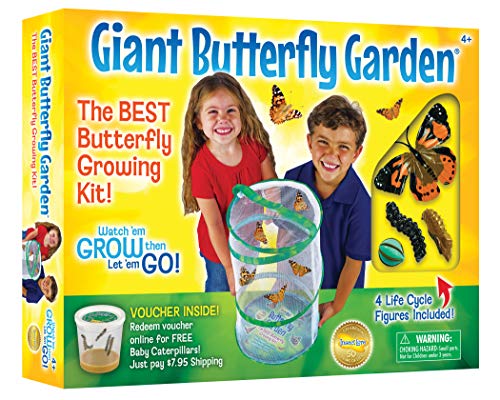On this page: General Resources | Ants | Bees | Beetles | Butterflies | Cicadas | Mosquitoes | Scientist Biographies
general resources
📖 Smithsonian Handbooks: Insects by George McGavin. This is a great reference guide to insects. The front material contains general information about insect anatomy, behavior, life cycle, and classification, along with a handy identification key that helps readers learn to distinguish among different types of arthropods. The remainder of the book is a heavily illustrated encyclopedia of insects. Also see Smithsonian Handbooks: Butterflies & Moths. – All
📖 What to Expect When You're Expecting Larvae by Bridget Heos. "Congratulations, insect parents-to-be! Youre about to meet your squirmy, wormy bundles of joy. Theyre called larvae. Read this book to find out where to lay your eggs, how many babies to expect, what theyll eat, and how to keep them safe from harm." Bridget Heos' What to Expect When You're Expecting books are hilarious, clever, and really informative. This one makes a perfect addition to an elementary or even middle school study of insects. – Elementary
▶️ A simple way to tell insects apart from TED-Ed. “There are nearly a million known insect species in the world, but most have one of just five common types of mouthparts. Why is this information useful to scientists? Anika Hazra explains how the features of an insect’s mouthparts can help identify which order it belongs to, while also providing clues about how it evolved and what it feeds on.” – All
▶️ Why the insect brain is so incredible from TED-Ed. “The human brain is one of the most sophisticated organs in the world, a supercomputer made of billions of neurons that control all of our senses, thoughts, and actions. But there was something Charles Darwin found even more impressive: the brain of an ant, which he called “one of the most marvelous atoms of matter in the world.” – All
▶️ Why are there so many insects? from TED-Ed. “If insects suddenly morphed into large beings and decided to wage war on us, there’s no doubt that humans would lose. There are an estimated 10 quintillion individual insects on earth, outnumbering humans by more than a billion to one. So what’s their secret to success? Murry Gans details the reasons behind insect abundance.” – All
ants
📖 The Life and Times of the Ant by Charles Micucci. A great starting point for a study of ants, this heavily illustrated book provides plenty of information on the social structure, behavior, anatomy, and history of these fascinating creatures. – Preschool • Elementary
🖐️ Ant Farm. A must-have resource if you're serious about studying ants. The linked product is an AntWorks farm filled with blue nutrient gel and equipped with an LED light. Note that you typically need to order your ants separately, either from the manufacturer or from live-ants.com (where you can also purchase gel refills). Ants only live 1-3 months, and if you want your colony to self-perpetuate, you will need to find a queen ant. – All
▶️ World War Ant from Kurzgesagt. Every day billions of soldiers fight a merciless war on thousands of fronts, that has been going on for over one hundred million years: The world war of the ants. – All
▶️ The billion ant mega colony and the biggest war on Earth from Kurzgesagt. In nearly every corner of the Earth, ants wage war against each other. Their weapons are what nature gave them. Some have strong armour, deadly stingers or sharp mandibles. And then there is this tiny, and not very impressive ant. But it rules the biggest empire any ant has ever built. A colony spanning continents and fighting wars that leave millions of casualties. Let’s take a look at this unlikely warrioress: Linepithema humile, the Argentine ant. – All
▶️ Inside the ant colony from TED-Ed. “Ants have one of the most complex social organizations in the animal kingdom; they live in structured colonies that contain different types of members who perform specific roles. Sound familiar? Deborah M. Gordon explains the way these incredible creatures mate, communicate and source food, shedding light on how their actions can mimic and inform our own behavior.” – All
▶️ The life of a fire ant queen from TED-Ed. In the spring, just after a heavy rainfall, male and female fire ants swarm the skies for a day of romance, known as the nuptial flight. Thousands of reproduction-capable ants take part in a mating frenzy, and for one successfully mated female, her work is only beginning. Walter R. Tschinkel details how the new queen builds a colony and protects it from neighboring ant armies. – All
bees & wasps
📖 The Magic School Bus Inside a Beehive by Joanna Cole & Bruce Deegan. The eccentric Ms. Frizzle takes her students on a field trip to visit a beekeeper—but, of course, since it's the Magic School Bus, the students find themselves turned into honey bees, and get a firsthand look at life inside a beehive. Like all MSB books, this title is both entertaining and informative. – Preschool • Elementary
📖 The Life and Times of the Honeybee by Charles Micucci. This book is definitely worth including in a unit on bees—learn about the different kinds of honeybees, bee communication, how honey is made, and the history of bee-human interactions. – Preschool • Elementary
📖 The Flight of the Honey Bee by Raymond Huber. Accompany Scout the honeybee as she leaves the hive on her first flight in search of the last flowers of fall. Along the way, she confronts a range of dangers, from birds to wasps to hailstones. Snippets of factual information accompany the simple prose. – Preschool • Elementary
📖 The Honeybee Man by Lela Nargi and Kirsten Brooker. The title character of this charming little picture book makes honey on the roof of his Brooklyn apartment building. The end notes share "some amazing facts about honey, honeybees, and beekeepers." – Preschool • Elementary
📖 The Case of the Vanishing Honeybees: A Scientific Mystery by Sandra Markle. Since 2006, honeybee colonies worldwide have been collapsing at an alarming rate. In this excellent book, Markle details the efforts of scientists and beekeepers to understand and respond to Colony Collapse Disorder (CCD). This book provides a nice illustration of the scientific method at work. – Elementary • Middle
📖 Honey Bees: Letters from the Hive by Stephen Bachmann. This engagingly-written 150-page chapter book is a terrific resource for students with a deep interest in the topic. Read about life inside a beehive, follow a year in the life of a beekeeper, and learn about the history of honey from ancient times to the present day. Adapted from Buchmann's adult book, Letters from the Hive. – Middle
🔗 Content Connection: Conservation. Learn about conservation and the importance of healthy ecosystems to bees and other insects.
▶️ The death of the bees explained – parasites, poison and humans from Kurzgesagt. “Bees are still dying in masses. Which at first seems not very important until you realize that one third of all food humans consume would disappear with them. Millions could starve. The foes bees face are truly horrifying—some are a direct consequence of human greed. We need to help our small buzzing friends or we will face extremely unpleasant consequences.” – All
▶️ Inside the hive from PBS. Take a close-up look at the inside of a beehive in this brief clip from the PBS episode, "Silence of the Bees."– All
▶️ The reign of a wasp queen from TED-Ed. Take a look inside a hive as a wasp queen begins her reign; founding a colony, hunting to feed her brood and defending against intruders. – All
beetles
📖 A Beetle is Shy by Dianna Hutts Aston. “A beetle is shy. It begins its life inside an egg … soft and wingless, tender, protected by the roots of trees and the undersides of leaves.” With her trademark gentle text and lovely, informative illustrations, Hutts Aston provides a gentle introduction to the shy beetle. Highly recommended for preschool or young elementary. – Preschool • Elementary
📖 Behold the Beautiful Dung Beetle by Cheryl Bardoe. "Think dung is gross? For a dung beetle, it's food, drink, and fuel for new life. Think dung beetles are disgusting? Take a closer look, and discover the beauty of these diamonds in the dung." Learn about the three different kinds of dung beetle in this interesting little book. – Elementary
butterflies
📖 From Caterpillar to Butterfly by Deborah Heiligman. This stage 1 Let's-Read-and-Find-Out title offers the simplest explanation of the stages of metamorphosis. Great for the very young. – Preschool • Elementary
📖 A Butterfly Is Patient by Dianna Hutts Aston. Lyrical, informative, and beautifully illustrated with detailed watercolors, Aston's A Butterfly Is Patient is an excellent addition to an elementary-level study of butterflies. – Preschool • Elementary
📖 Handle with Care: An Unusual Butterfly Journey by Loree Griffin Burns. Visit a butterfly farm in Costa Rica that supplies pupae to butterfly pavilions around the world. The book includes nice photographic images and is worth borrowing from the library. – Elementary
🖐️ Butterfly Garden. Get a close-up look at metamorphosis with a butterfly garden. The linked image is for an Insect Lore Giant Butterfly Garden, which comes with a voucher for caterpillars that may be redeemed online. These caterpillars will become Painted Lady butterflies. As the website explains, you'll want to consider the season when planning this project, as daytime temperatures should be at least 55 ºF when the butterflies are released (3-4 weeks after the caterpillars arrive). – All
▶️ The weird and wonderful metamorphosis of the butterfly from TED-Ed. “In order to become a butterfly, a caterpillar’s body dissolves almost completely and is rebuilt from its own juices. Butterflies are just a few of the 800,000 insect species that transition from larvae to adults through complete metamorphosis. But how exactly does this process work? Franziska Bauer explains how these squishy larvae emerge as armored, aerodynamic, and nimble adults.” – All
cicadas
▶️ Cicadas: the dormant army beneath your feet from TED-Ed. “Every 13 or 17 years, billions of cicadas emerge from the ground to molt, mate and die. Adult cicadas only live a few weeks above ground, but you’d be hard pressed to ignore them—they are extremely loud! Rose Eveleth explains everything you need to know about these noisy insects, admitting that there’s still some things we just don’t understand.” – All
mosquitoes
📖 Mosquito Bite by Alexandra Siy. This surprisingly informative picture book follows a female mosquito, Culex pipiens, as she searches for her next meal:" . . . astonishing micrographs show Culex and her world as seen through an electron microscope. Zoom in for a close-up view: A blade of grass looks like a menacing field of spines. A mosquito's eye becomes a bundle of tightly packed tubes." Includes information about the life cycle of this insect. – Elementary
▶️ The loathsome, lethal mosquito from TED-Ed. “Everyone hates mosquitos. Besides the annoying buzzing and biting, mosquito-borne diseases like malaria kill over a million people each year (plus horses, dogs and cats). And over the past 100 million years, they've gotten good at their job—sucking up to three times their weight in blood, totally undetected. So shouldn't we just get rid of them? Rose Eveleth shares why scientists aren't sure.” – All
scientist biographies
📖 Small Wonders: Jean-Henri Fabre and His World of Insects by Matthew Clark Smith. "Meet Jean-Henri Fabre, one of the most important naturalists of all time. As a boy in the French countryside, Henri spent hours watching insects. He dreamed of observing them in a new way: in their own habitats. What he discovered in pursuing that dream was shocking; these small, seemingly insignificant creatures led secret lives—lives of great drama!" A lovely, charmingly illustrated biography. – Elementary




















